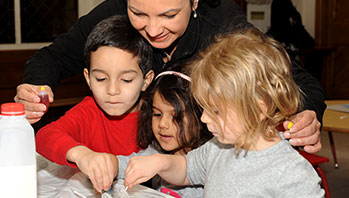- pots
- science notebooks
- soil
- sunflower seeds
- sunflower stickers
- garden
- grow
- plant
- seed
MA Standards:
English Language Arts/Speaking and Listening/SL.PK.MA.1: Participate in collaborative conversations with diverse partners during daily routines and play.
MA Draft Standards:
Life Sciences/Ecosystems; Biological Evolution/LS2/4.B: Using their experiences in the local environment and other evidence, raise and discuss questions about the basic needs of familiar organisms and how they might meet their needs. (Clarification statement: basic needs include water, food, air, shelter, and light for most plants)
Head Start Outcomes:
Science Knowledge/Conceptual Knowledge of Natural and Physical Worlds: Observes, describes, and discusses living things and natural processes.
Science Knowledge/Scientific Skills and Method: Collects, describes, and records information through discussions, drawings, maps, and charts.
PreK Learning Guidelines:
English Language Arts/Language 2: Participate actively in discussions, listen to the ideas of others, and ask and answer relevant questions.
Science and Technology/Life Sciences 10: Observe and identify the characteristics and needs of living things: humans, animals, and plants.
Science and Technology/Inquiry Skills 4: Record observations and share ideas through simple forms of representation such as drawings.
Small Group: Plant Sunflowers

© Commonwealth of Massachusetts, Department of Early Education and Care (Jennifer Waddell photographer). All rights reserved.
STEM Key Concepts: Some plants start from seeds; Plants need water and sunlight to grow; Plants grow in places where they get their needs met; Plants often grow in some type of dirt; Do simple experiments, talk about cause and effect, and share ideas
ELA Focus Skills: Compare and Contrast, Following Directions, Listening and Speaking, Vocabulary
Safety Tip: Remind children to wash their hands before and after the activity.
Pass around some sunflower seeds. Discuss how the seeds are like the bean and grass seeds children have used and how they are different. Remind children of how Peep’s sunflower grew and guide children to understand that just one sunflower seed can grow into a very big flower.
Tell children they will plant the seeds in small pots, but when they begin to grow they will need to plant them in bigger pots. Ask, Why do you think you will need to plant the plants into bigger pots once they start to grow?
Then have children plant their seeds. Plant extra seeds in case some of the children’s seeds do not sprout. Ask questions such as,
- What will our sunflower seeds need in order to grow? (water, sun, air)
- Why do you think it’s a good idea to plant extra sunflower seeds? Do you think all the seeds will grow?
Once seeds are planted, have children open to a blank page in their science notebook. (You may need to add pages to the notebooks by stapling in more pages.) Direct each child to put a sunflower sticker on the blank page and say, This page is your sunflower page. Turn to this page whenever you want to draw or write about the changes the sunflower seeds go through. Help children write “My Sunflower” next to the sticker.
Educator Tip: The sunflowers should sprout within a week, become seedlings in two weeks, and, especially if replanted outdoors, be about 2-feet tall in a month. The buds will flower in about eight weeks, revealing hundreds of seed kernels.
Educator Tip: You may want to start a “watering chart” and assign different children to water the garden a few days a week (with supervision).
Adaptation: If very young children have trouble planting the seeds and watering them, work one-on-one, holding their hands to help them place the seeds and spray the water.
